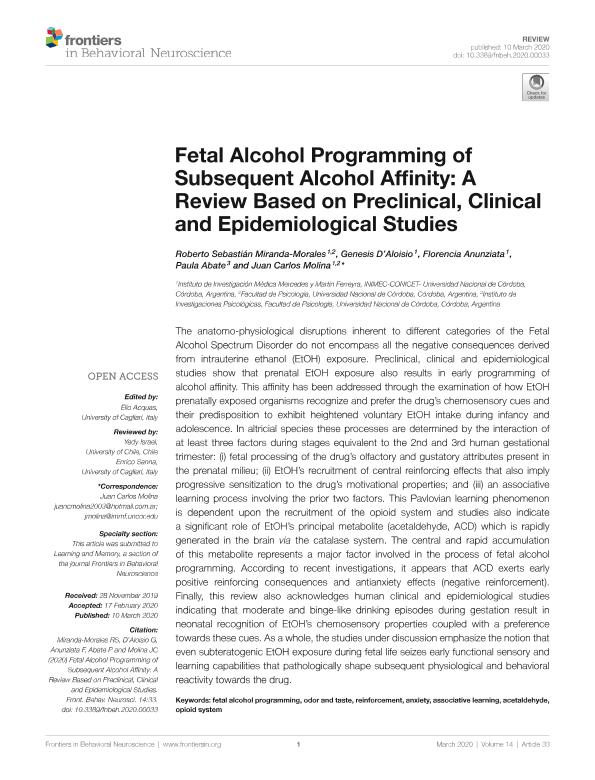Mostrar el registro sencillo del ítem
dc.contributor.author
Miranda Morales, Roberto Sebastián

dc.contributor.author
D'aloisio, Génesis

dc.contributor.author
Anunziata, Florencia

dc.contributor.author
Abate, Paula

dc.contributor.author
Molina, Juan Carlos

dc.date.available
2020-08-11T20:26:43Z
dc.date.issued
2020-04
dc.identifier.citation
Miranda Morales, Roberto Sebastián; D'aloisio, Génesis; Anunziata, Florencia; Abate, Paula; Molina, Juan Carlos; Fetal alcohol programming of subsequent alcohol affinity: A reviewb ased on preclinical, clinical and epidemiological studies; Elsevier; Frontiers in Behavioral Neuroscience; 4-2020; 14-33
dc.identifier.uri
http://hdl.handle.net/11336/111491
dc.description.abstract
The anatomo-physiological disruptions inherent to different categories of the Fetal Alcohol Spectrum Disorder do not encompass all the negative consequences derived from intrauterine ethanol (EtOH) exposure. Preclinical, clinical and epidemiological studies show that prenatal EtOH exposure also results in early programming of alcohol affinity. This affinity has been addressed through the examination of how EtOH prenatally exposed organisms recognize and prefer the drug´s chemosensory cues and their predisposition to exhibit heightened voluntary EtOH intake during infancy and adolescence. In altricial species these processes are determined by the interaction of at least three factors during stages equivalent to the 2nd and 3rd human gestational trimester: (i) fetal processing of the drug´s olfactory and gustatory attributes present in the prenatal milieu; (ii) EtOH´s recruitment of central reinforcing effects that also imply progressive sensitization to the drug´s motivational properties; and (iii) an associative learning process involving the prior two factors. This Pavlovian learning phenomenon is dependent upon the recruitment of the opioid system and studies also indicate a significant role of EtOH´s principal metabolite (acetaldehyde, ACD) which is rapidly generated in the brain via the catalase system. The central and rapid accumulation of this metabolite represents a major factor involved in the process of fetal alcohol programming. According to recent investigations, it appears that ACD exerts early positive reinforcing consequences and antianxiety effects (negative reinforcement). Finally, this review also acknowledges human clinical and epidemiological studies indicating that moderate and binge-like drinking episodes during gestation result in neonatal recognition of EtOH´s chemosensory properties coupled with a preference towards these cues. As a whole, the studies under discussion emphasize the notion that even subteratogenic EtOH exposure during fetal life seizes early functional sensory and learning capabilities that pathologically shape subsequent physiological and behavioral reactivity towards the drug.
dc.format
application/pdf
dc.language.iso
eng
dc.publisher
Elsevier
dc.rights
info:eu-repo/semantics/openAccess
dc.rights.uri
https://creativecommons.org/licenses/by-nc-sa/2.5/ar/
dc.subject
Acetaldehyde
dc.subject
Anxiety
dc.subject
Associative learning
dc.subject
Fetal alcohol programming
dc.subject
Odor and taste
dc.subject
Opioid system
dc.subject
Reinforcement
dc.subject.classification
Neurociencias

dc.subject.classification
Medicina Básica

dc.subject.classification
CIENCIAS MÉDICAS Y DE LA SALUD

dc.title
Fetal alcohol programming of subsequent alcohol affinity: A reviewb ased on preclinical, clinical and epidemiological studies
dc.type
info:eu-repo/semantics/article
dc.type
info:ar-repo/semantics/artículo
dc.type
info:eu-repo/semantics/publishedVersion
dc.date.updated
2020-05-07T14:22:03Z
dc.identifier.eissn
1662-5153
dc.journal.pagination
14-33
dc.journal.pais
Suiza

dc.journal.ciudad
Lausanne
dc.description.fil
Fil: Miranda Morales, Roberto Sebastián. Consejo Nacional de Investigaciones Científicas y Técnicas. Centro Científico Tecnológico Conicet - Córdoba. Instituto de Investigación Médica Mercedes y Martín Ferreyra. Universidad Nacional de Córdoba. Instituto de Investigación Médica Mercedes y Martín Ferreyra; Argentina
dc.description.fil
Fil: D'aloisio, Génesis. Universidad Nacional de Córdoba. Facultad de Psicología; Argentina. Consejo Nacional de Investigaciones Científicas y Técnicas. Centro Científico Tecnológico Conicet - Córdoba. Instituto de Investigación Médica Mercedes y Martín Ferreyra. Universidad Nacional de Córdoba. Instituto de Investigación Médica Mercedes y Martín Ferreyra; Argentina
dc.description.fil
Fil: Anunziata, Florencia. Consejo Nacional de Investigaciones Científicas y Técnicas. Centro Científico Tecnológico Conicet - Córdoba. Instituto de Investigación Médica Mercedes y Martín Ferreyra. Universidad Nacional de Córdoba. Instituto de Investigación Médica Mercedes y Martín Ferreyra; Argentina
dc.description.fil
Fil: Abate, Paula. Consejo Nacional de Investigaciones Científicas y Técnicas. Centro Científico Tecnológico Conicet - Córdoba. Instituto de Investigación Médica Mercedes y Martín Ferreyra. Universidad Nacional de Córdoba. Instituto de Investigación Médica Mercedes y Martín Ferreyra; Argentina
dc.description.fil
Fil: Molina, Juan Carlos. Universidad Nacional de Córdoba. Instituto de Investigaciones Psicológicas. - Consejo Nacional de Investigaciones Científicas y Técnicas. Centro Científico Tecnológico Conicet - Córdoba. Instituto de Investigaciones Psicológicas; Argentina
dc.journal.title
Frontiers in Behavioral Neuroscience
dc.relation.alternativeid
info:eu-repo/semantics/altIdentifier/url/https://www.frontiersin.org/article/10.3389/fnbeh.2020.00033/full
dc.relation.alternativeid
info:eu-repo/semantics/altIdentifier/doi/https://doi.org/10.3389/fnbeh.2020.00033
Archivos asociados
